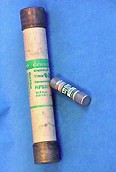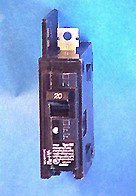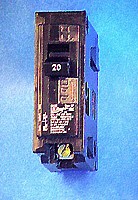 |
 |
| 15 amp fuse type t This fuse is typical of those found in an older home. | 450 to 600 amp fuse (note size of penny) A fuse such as this might be used with a large piece of equipment. |
OVERLOADING CIRCUITS
To keep a home safe it is important not to put too much electricity on one circuit. Overloading a circuit cause a problem like a fire in the fuse box.
To avoid electrical accidents, fuses and circuit breakers are used in homes and businesses today.
FUSES
 |
 |
| 15 amp fuse type t This fuse is typical of those found in an older home. | 450 to 600 amp fuse (note size of penny) A fuse such as this might be used with a large piece of equipment. |
A plug fuse such as the one shown here screws into an electrical circuit. When an overload of current melts the metal strip, the fuse must be replaced to restore the circuit. Fuses are found in some homes, cars, and other electrical systems.
Older homes often have fuse boxes. These homes have different electrical requirements, but their safety systems are also designed to shut off the electricity when there is a problem.
 |
 |
 |
 |
| Fuse in fuse block. | Electrical safety fuse, 200 amp. | 30 amp fuse (left) and time delay fuse (right) | Fuses in box |
CIRCUIT BREAKERS
|
A breaker is a switch that automatically opens or interrupts an electrical circuit under conditions of excessive current, voltage, temperature, or other unsafe conditions. A mechanical device breaks the flow of electricity when a problem occurs. A circuit breaker can be reset to close the circuit after the problem has been fixed. |
Residential circuit breaker box |
Circuit breakers are found in homes and businesses. Businesses have the same type of breakers and fuses as residential housing electrical systems. They all run the same way as all the other breakers and fuses.
New construction usually uses circuit breakers instead of fuses. New homes do not have to have a specific type of circuit breaker. Builders have to meet a certain electrical requirements or codes for new construction.
 |
 |
 |
| Circuit breaker type BQ | Circuit breaker -I-T-E | Circuit breaker |
| ELECTRICAL SAFETY HOME PAGE |
|